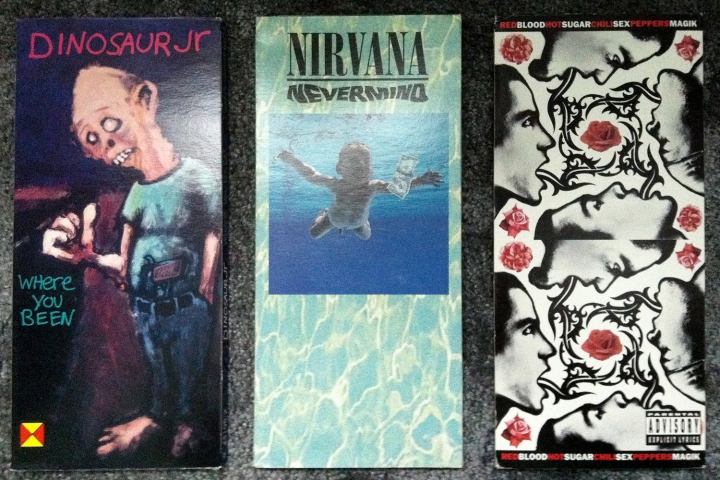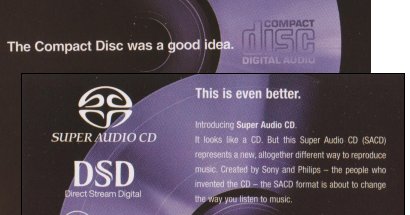First launched: October 1982
Uses: Audio storage, data storage, video storage (VCDs)
Fun fact: the first CDs were stored in huge 6” by 12” boxes (longboxes), to prevent theft and to fit in LP storage shelves.

First launched: October 1982
Uses: Audio storage, data storage, video storage (VCDs)
Fun fact: the first CDs were stored in huge 6” by 12” boxes (longboxes), to prevent theft and to fit in LP storage shelves.

Compact Discs are one of the longest lasting and most flexible storage mediums to date. While it was the second commerically available optical media format (the first being LaserDisc), the CD was the first to garner a huge user-base. Co-developed by Sony and Philips in the 1970s, CDs operate in a very similar way to LaserDisc, where a laser is shined at a reflective disc covered in tiny pits containing the data. This video is a great primer on the technology itself.
The development and release of the CD coincided with the mainstream adoption of digital audio recording technology. Many CDs have the SPARS code of DDD on the cover - meaning it was digitally recorded, mixed, and mastered (more here).
CDs retained things like high-quality album art, liner notes, and the ability for strong packaging and design, while still being small enough to store efficiently. The CDs themselves were printable, allowing for artists to leave their mark on the disc and leading to some memorable designs.
Examples:The sound quality of the CD format was clean and detailed - some early recordings released on CD may have been mixed or mastered in a less ‘vibrant’ way than on vinyl, leading people to believe it was a limitation of the medium itself (it wasn’t). Most CDs in the wild adhere to the ‘Red Book’ standard (first published in 1980), being 16bit 44.1Khz 2 channel PCM.
Despite the high level of fidelity already afforded by Red Book CDs, marketing and audiophiles demanded more - so a number of derivatives to the format were developed. The Super Audio CD (SACD) was probably the biggest among the lot (some examples are the XRCD, HDCD, SBM-mastered CDs, etc…). Instead of using PCM technology to store the audio, it used DSD (Direct Stream Digital), and were usually dual-layer to provide backwards compatibility with CD players.
DSD was once again developed by Sony and Philips, touting more dynamic range and frequency response (much of which was beyond the range of adult human hearing). The irony of the format was that many albums were in fact recorded in PCM, which then had to be converted into DSD. Kind of like having a compressed image and resizing it to be a little bigger. Despite this, some people have claimed to find the recordings far more musical and superior to standard Red Book CDs, and the format has a small but dedicated user-base.

A related medium was MiniDisc - a small optical disc
format that aimed to replace cassette tapes in the portable market. It
had plenty of charm: retaining the novelty of the miniature nature of
cassettes, a visually attractive transparent design, better audio
quality than cassette (even comparable to CD).
Despite the existence of portable CD players, MiniDisc had some definite advantages:
However, the drawbacks prevented widespread adoption. The players and discs were prohibitively expensive up until the last years of its lifespan - something that alienated teens and adolescents as they couldn’t afford them. Audiophiles wouldn’t buy them because they saw the compressed audio as too compromised.
The recordability factor was a sign of consumer habits to come, though: those who did buy a MiniDisc player could source their music from a variety of sources. Apart from their own collections, radio broadcasts, files on a computer, borrowed CDs, even rented CDs were all fair game. The ability of the consumer to make their own mixes was more fully realised when CD-R discs and recordable drives became far cheaper in the early 2000s, allowing for users to rip CDs from anywhere, save them as files on their computer, and then burn them onto a cheap disc.
This is a great short video about the medium; for a more in-depth look please check out the video in Further Reading by This Does Not Compute.